2012 Ford Fiesta SES hatchback. Click image to enlarge |
| Test Drive: 2011 Ford Fiesta SEL First Drive: 2011 Ford Fiesta DBDR: 2011 Ford Fiesta SESManufacturer’s website Ford Motor Company of Canada |
Review and photos by Chris Chase
Photo Gallery:
2012 Ford Fiesta
America’s automakers are getting more serious than ever about taking on the imports on their own turf. Dodge’s Alfa Romeo–based Dart is coming soon, Chevrolet’s Cruze is a global car sold in near-identical form around the world, as is Ford’s compact Focus.
Ford’s other small car, the subcompact Fiesta, has a similar international lineage. It was introduced to us North Americans in 2010 as a 2011 model, to do battle against established little cars like the Toyota Yaris, Honda Fit, Hyundai Accent, and Chevrolet Aveo, which was then replaced by the far-superior Sonic.
Changes for the 2012 Fiesta are minor. There’s a new base hatchback, in the entry-level S trim level, so the five-door lineup now echoes that of the sedan. Hatchback trims are S, SE, and SES, while the sedan can be had as S, SE, and SEL models. SE, SEL, and SES models get a driver’s seat armrest and available remote start and keyless entry keypad, and satellite radio is available in SE trim. The rest of the Fiesta, including its 1.6L four-cylinder engine (120 hp, 112 lb-ft of torque) and standard five-speed manual and optional six-speed dual-clutch automatic transmissions, is carried over unchanged. The Fiesta I tested last year had the five-speed manual transmission; this time around, Ford sent one with the optional six-speed PowerShift dual-clutch automatic.
2012 Ford Fiesta SES hatchback. Click image to enlarge |
As I wrote in my mini-review of the Focus included in our recent compact car comparo, this gearbox likes it rough, responding to aggressive acceleration with smooth, quick shifts every time. The automatic’s extra gear ratio and gear spacing are better suited to the Fiesta’s motor, but as in the larger Focus, the transmission’s operation in normal driving is disappointing, at least as compared to dual-clutch gearboxes from Mitsubishi and Volkswagen. At around-town speeds, it can feel clunky and indecisive, it’s slow to downshift for acceleration, and there’s an occasional shudder from the clutch as first gear is engaged. A manual control option would be nice, too. Such a thing is available (but not standard) with this transmission in the Focus, but here, you’re stuck with an overdrive lockout and a low range, which simply keeps the car in the lowest gear possible without over-revving the engine.
The transmission’s ratios are well matched to the engine, and certainly better than the five gears in the manual, which are spaced too far apart to keep the motor in its torque sweet spot. The engine itself is a smooth, eager-revving piece. It never feels more powerful than its 120 hp (at 6,350 rpm) and 112 lb-ft of torque (peaking at an also-high 5,000 rpm) but is nonetheless entertaining to run out to its rev limit.
With the automatic transmission, the Fiesta’s Natural Resources Canada fuel consumption ratings are 6.9/5.1 L/100 km (city/highway), or 8.1/6.0 by the U.S. EPA’s more realistic testing standard. My test car averaged 7.6 in mostly city driving. (A 2011 Fiesta with a manual transmission that I tested in the summer of 2010 also averaged 7.6 in the city, and 6.4 on a short highway trip.)
The Fiesta is one of the more grown-up subcompacts available, and that’s reflected in the way it drives. It goes over the road relatively quietly and without drama, but still has something to offer the enthusiast driver. Its handling is sharp and the ride is comfortable but well controlled. The real negative for the enthusiastic driver is the mushy brake pedal.
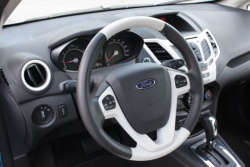 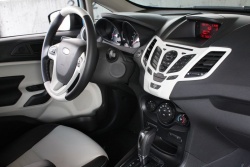 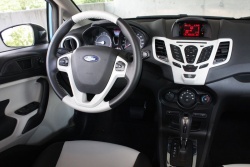 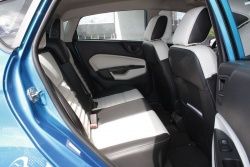 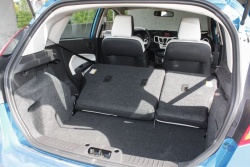 2012 Ford Fiesta SES hatchback. Click image to enlarge |
The trade-off is that it’s easy to drive the Fiesta’s price up with options. My SES hatch tester—the top hatchback trim, mind you—starts at $18,999. To that, Ford added the automatic transmission ($1,250), the new-for-2012 premium sport appearance package ($800), premium interior package ($1,400), intelligent keyless access ($500), remote starter ($300), an obnoxious exterior graphic ($500) and an engine block heater ($100), which took the as-tested price to $23,979, before freight and taxes.
An SE hatch is a more reasonable choice, price-wise. It starts at $15,999 and can be had with a few niceties—including heated seats, SYNC, upgraded stereo and satelitte radio and the automatic transmission, for a little more than $18,000.
One option conspicuous by its absence, in a car offered with so many other luxury items, is automatic air conditioning. For my test car’s 24-grand price, I’d want it.
As much as I want to, I can’t quite warm up to the Fiesta’s interior. I (still) don’t like the radio button layout, and frankly find certain aspects of it infuriating. I really don’t like the central control joystick, which isn’t tall enough to be a proper stick, and the buttons that form the base of it are too small to use as buttons. And also, why do the steering wheel–mounted audio controls not include a volume adjustment?
If you can get past those things (the radio alone is nearly a deal-breaker for me), you’ll probably be happier with the front seats, which are narrow but comfortable, if not terribly supportive for spirited driving. A height-adjustable driver’s seat and tilt-and-telescopic steering make it easy to get comfortable behind the wheel.
Front seat space is good for what this car is, but as with any subcompact, the Fiesta can only comfortably accommodate tall people in front or in back, but not both. Rear seat headroom is good.
For those who think all hatchbacks are good at moving any kind of bulky cargo, think twice. The Fiesta hatch’s 435 L trunk is a decent size, and the back seats (naturally) fold down, but the cabin is small enough that an adult-size bike will barely fit, even with the front wheel removed, and this only when the front seats have been moved forward a few notches, potentially making for an uncomfortable (and not entirely safe) trip. The other knock against the Fiesta’s cargo-hauling abilities is that the back seat doesn’t fold anywhere close to flat with the cargo floor.
Interior quality is good, but that’s as far as I’d go in complimenting it. The materials are fine, but the iffy fit of a few panels caught my eye, mostly where the standard black bits and my car’s optional white panels mated.
What I find myself wishing for whenever I drive a Fiesta is that I could have its engine and looks, along with the Honda Fit’s interior and the Chevy Sonic’s lovely six-speed manual transmission. The Fiesta makes many promises with its European heritage, but doesn’t deliver on all of them.
|
Pricing: 2012 Ford Fiesta SES hatchback
Specifications
Competitors
Crash test results
|











